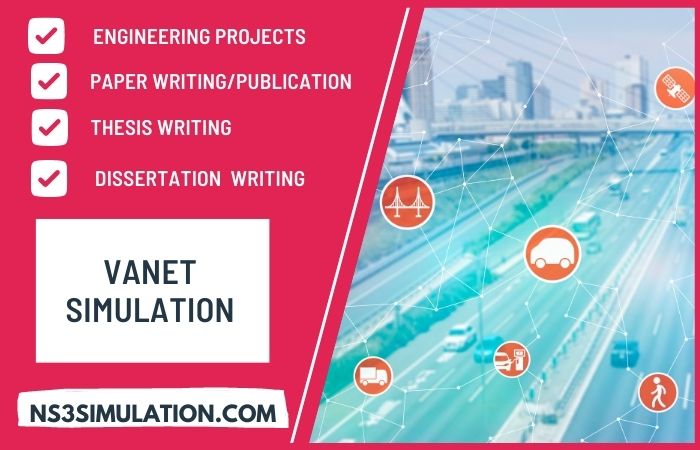Vehicular Ad-hoc Networks (VANET) are the subset of Wireless Ad-hoc networks specially introduced for the intelligent transportation system. It interconnects the massive range of vehicles in the distributed network. The main motive of Vanet Simulation is to increase vehicular interaction and driver safety in the case of undesired circumstances. Moreover, the VANET simulation comprises a mobility model and network simulator to analyze the simulated VANET model behaviour.
This page completely describes the VANET project simulation with supporting simulators!!!
Now, we can see the architecture of the VANET model. Generally, the VANET model encompasses five different layers such as physical, network, security, MAC, and application layers. These layers are differentiated based on their features and responsibilities to perform in vehicular communication. Below, we have given you some primary functions involved in each layer.
VANET Architecture
- Physical Layer
- Modulation Type
- Multiple Antenna
- IEEE 802.11p Protocol
- Spectrum Provisioning
- Network Layer
- Remodelling of geocast, multicast, broadcast, unicast
- Routing on Multi-hop Communication
- Security Layer
- Data Privacy and Integrity
- Authentication and Accessibility
- Real-Time Limitations
- Minimal Overhead
- Anonymity Detection
- Media Access Control (MAC) Layer
- RR-ALOHA, IEEE 1609.4 and IEEE 802.11p Protocol
- Prevention of Communication Collision
- Consistent Medium Access
- Application Layer
- Web Connectivity
- Vehicle-to-Vehicle Connectivity
- Local Roadside Unit Connectivity
In addition, we have also given the notable characteristics of VANET Simulation and modelling. These characteristics play a key role in developing customized vehicular applications and services. Also, it directs the current VANET technologies towards future advancements.
Specific Features for VANET Simulation
- Enhancing the accuracy of vehicle position. For that, it utilizes several intelligent techniques of location reference to create local maps
- Enable to design and develop new protocols for V2V and V2I communications
- Designing tools to find and analyze the technical problems related to the small and large-scale simulations
- Able to develop intellectual model to control traffic control for quick identification of incidents / accidents for roadside / vehicle systems
- Empower to create different kinds of applications such as driver aids, mobility service, traffic and resource management, etc.
What is VANET Simulation?
In general, the virtualization of the VANET environment incorporates 2 primary entities such as network simulator and a vehicular traffic simulator. Here, the network simulator is used to assess the network behaviour, and the traffic simulator is used to instigate the mobility models of deployed nodes. Next, we can see the reason behind the utilization of VANET simulation.
What are the needs of VANET Simulation?
- VANET simulation tools allow you to check the performance of the VANET network at a minimum price without creating threats to the connected users
- Enables to model and virtualize the emerging technologies as 5G, SDN, edge computing, etc. in the VANET framework to achieve maximum security
- Helps to increase the VANET improvement in multiple aspects
- Support you to develop any kind of complicated VANET scenarios
- Furnished with macro and micro-mobility specifications
- Allow creating VANET specific and open-source software and services
- One developed mobility model can be simulated in various network configurations
We hope that you are clear about VANET architecture, features, vanet simulation, and their needs. Now, we can see the key points that are required to be noted while choosing the VANET simulator. Since the handpicked appropriate simulator provides accurate experimental results.
How to select the VANET simulation tool?
- For reducing the manual power and cost of real vehicular network investigation, everybody is moving on towards network simulation.
- For improving the network efficiency, the simulator helps to incorporate different channel models, mobility models, and driver behavior
- For achieving actual vehicular traffic with the expected outcome, it allows integrating the mobility models with network simulator
- For checking the network behavior in different scenarios, simulators are used. Further, it is also capable to assess the complex infrastructure to yield accurate results than real testbeds.
On the whole, VANET simulator selection needs more concern to accomplish real traffic flow with expected results. For your benefit, we have discussed more different VANET simulators in the upcoming sections. Certainly, it helps you to compare the tools with one another. Here, we have given you the things that are connected wholly to form the VANET simulation environment.
VANET Simulation Environment
- Communication Model
- Signal Propagation Model
- Stochastic and Deterministic Models
- Mobile Obstructions Model (dynamic vehicles)
- Fixed Obstructions Model (static vehicles, hills, building, etc.)
- Node Mobility Model
- Dedicated Traffic
- Execution of Traffic flow (speed models, crossing control, etc.)
- Varied Mobility Patterns (manhattan grid, road-restricted, random waypoint, etc.)
- Vehicular Data Exchange (calamity simulation, lane shifting, etc.)
- Trace-assisted Mobility
- Artificial and Real-time Traces
- Dedicated Traffic
Next, we can see the working procedure of the VANET model in simulation. From this, you can get an idea about how the VANET model is simulated in the VANET infrastructure. And, the procedure may vary based on the requirements of the project.
VANET Simulation Procedure
- Set the VANET infrastructure by deploying N number of vehicles and Road Side Units (RSUs)
- Start the simulation
- Initiate the node mobility
- Transmit the data packets from source node
- Receive the data packets by destination node
- End the Simulation
Our developers have more than enough practice in all possible precise results generating VANET simulation tools. So, we are adept to guide you in identifying the best-fitting tool for your handpicked VANET project. Below, we have listed the different varieties of VANET simulators for your awareness.
Types of VANET Simulators
- Opnet Modeler
- Support both trajectory and random mobility
- For trajectory mobility model, each node encloses trajectory file
- However it enables to handle and describe complicated node mobility, it is constrained with real-time mobility due to continuous nodes communications
- TraNS (Traffic and Network Simulation Environment)
- First tool to combine sumo assisted vehicular mobility with network simulator
- In this, parse enable the connection between these tools through passing sumo output as input of NS-2.
- Further, it also uses traceexporter tool from sumo to integrate with ns-2
- SUMO
- Integrate with VANET network for designing the road traffic
- Further, include NetSim for designing IEEE WAVE / LTE
- In Veins (Vehicles in Network Simulation)
- Integrate sumo with omnet++ simulator for enabling bidirectional data exchange
- Flexible to respond to actions of mobility modelling tool
- TraNS + OPNET Modeler + VanetMobiSim:
- TraNS used to simulate VANET environment
- OPNET used to simulate and assess entire network
- VanetMobiSim used to initiate the node mobility in the network
- Swans++
- VANET simulator tool with the prolonged features of straw and vehicular mobility
- Here, the straw stands for Street Random Way point
- Further, it utilizes realistic street map collected from street database
- For instance: Topologically Integrated Geographic Encoding and Referencing (TIGER) database
- GrooveNet
- Extended tool of RoadNav simulator
- Type of vehicular mobility simulator which is called as GrooveSim
- Enable to design car-following model by incorporating realistic street map from tiger
For illustration purposes, here we have selected the VANET MobiSim Tool as the sample one. In this, we have discussed the installation and architectural requirements. It makes you understand how the VANET MobiSim and network simulator are functioned together to meet their requirements,
- At first, install the VANET MobiSim in windows OS
- Next, the mobility model generator make “.xml” file
- Then, it produces the mobility model
- After that, install the NS-2 in Linux OS
- Next, produce the “.tcl” file for the purpose of simulation
- Further, utilize cbrgen.tcl for primary “.tcl” file
- Start the simulation of the VANET model
- Then, produce the NS2 trace file and animate the model
- At last, examine the trace file to assess the network performance
Simulation Architecture
- In VANET MobiSim, the traffic generator produces the vehicular trace
- Then, the produced trace file is transformed to the NS-2 network simulator
- In Network Simulator, it creates the communication
- In overall, traffic simulator and network simulator have two different functionalities. Here, vehicular mobility traces are produced by traffic simulator and data exchange infrastructure is designed by network simulator
Furthermore, our developers have highlighted few significant files that generate the traffic, analyze the network performance, trace the network simulation and animate the network communication.
How does VANET MobiSim with NS2 simulation works?
- VanetMobiSim-1.1 (Traffic Generator)
- Vehicular Traffic Trace (.tr)
- Network Traffic Trace (.tr) (Network Simulator)
- Ns-2.35 TCL Script cbrgen.tcl
- Simulation Trace (.tr)
- Awk (Performance Fitor)
- Simulation Results
- Network Animator (.nam)
Other Tools for VANET Simulation
The first and foremost tool to appraise the network VANET performance is GrooveSim which is developed in C++. It is intended to design and predict the traffic flow in the network. Most importantly, it helps to examine the probability of real-world actions such as passing security messages. Additionally, the graphical interface of Matlab lets you get pictorial output as graphs.
Performance Analysis of VANET Simulation
In VANET, simulators are used to assess the efficiency of employed protocols and applications which yield huge data. Further, it also needs some special parameters for network evaluation. Through this, you can perform a comparative study of dissimilar environments. And, the parameters are:
- Connection and Simulation Time
- No of Disconnection
- Throughput
- No of Tries / Packet
How to set the parameters for VANET Simulation?
Basically, every simulation tool of VANET is differing from each other because of its functionalities. Furthermore, it also supports various parameters to improve and assess network performance. Depends on the project needs, we need to choose the tool and its key parameters. Our developers are well-versed in identifying the appropriate tool.
OMNeT ++
- Simulation Duration
- Mobility Model
- MAC layer
- Number of nodes
- Number of Iterations
- Velocity (speed)
- Propagation Model
- Coverage Capacity
OMNET++ VEINS
- Transmission Power
- Control and Guard Subcarrier
- Base Station and Vehicle Height
- RSU and OBU height
- Number of Vehicles and Subcarriers
- UE and ENodeB Transmission
- Simulation Duration and Area
- Pedestrian Walking and Vehicle Urban Speed
- Resource Block
- IEEE 802.11p (BW/frequency)
- LTE vehicles and BS antenna type
- Beacon Interval
- Propagation Analogue Model
- Header Packet Size
- maxOffset
- Data Transfer Rate
NS2 with SUMO
- Transport Protocol (TCP, UDP)
- Map Model (OSM)
- Routing Protocol (DSR, AODV, DSDV)
- Data Transfer Rates
- Minimum and Maximum Speed
- Application Type
- Propagation Model
- Code Rate
- Number of Vehicles
- Simulation Duration
- Modulation
- Packet Size
NS2
- Data Transmit Range
- MAC Protocol
- Count of Vehicles
- Channel bandwidth (capacity)
- Vehicle Velocity
- Simulation Coverage and Duration
- Radio Frequency (RF)
- CBR Flow of Data
- Propagation Model
Moreover, here our research team has given the emerging technologies that are growing fast in integrating with the VANET network. These areas have attained special places in VANET Simulation research. Our experts have more unique research ideas in the following areas to create futuristic VANET development
What are the integrated technologies supporting VANET?
- 5G Network
- Autonomous Vehicles
- Fog-Edge Computing
- Software Defined Network (SDN)
- Unmanned Aerial Vehicles (UAV)
Due to the VANET unique capabilities, it rapidly gains the attentions of scholars who are interested to do something new in the field of VANET. Also, this field motivates the scholars to develop real-time vehicular simulation through evolving security technologies and tools. In truth, our resource team has updated their knowledge on all these technological developments to support you in all respects of VANET. So, make use of this chance to get the masterwork in your research by contacting us.


